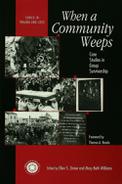Terrorism and Political Action
The third section of the book examines the special impact of terrorist acts and politically instigated deaths upon the communities which fall victim to intentional destruction.
When the Murrah Building in Oklahoma City exploded on Wednesday, April 19, 1995, taking 168 lives, Americans suddenly were forced to acknowledge that terrorism was not a misfortune that happened only outside its borders. When Americans sought a perpetrator among international terrorists, they found none. Instead, the perpetrator(s) were fellow citizens. The heinousness of the crime, reflected in the number of children murdered while playing at their daycare center, is well documented in Chapter 9. Karen Sitterle and Robin Gurwitch, who continue to be involved in intervention efforts in Oklahoma City, paint a picture of bereavement and overwhelming grief tempered by the outreach efforts of thousands of professionals, volunteers, and rescue workers. The description of memorialization and rituals is a moving and significant part of their account.
The Remembrance Day Bombing in Enniskillen, Northern Ireland, killed 11 people and injured over 60 in November 1987. David Bolton, an Enniskillen social worker, depicts the background of disaster in the context of conflict in Northern Ireland. He introduces several important concepts related to community recovery, including belonging, communality, resilience, and competency in coping. During this tragedy, the most significant source of support was the churches themselves. Bolton illustrates the concept of “emergent leaders” with the story of a bereaved father whose speech to all of Northern Ireland’s citizens set the tone for subsequent communal response. This bombing occurred within the context of historical intercommunity strife; healing occurred within a cultural context that relied on the use of group ritual and the desire for belongingness.
The final chapter in this section fits less comfortably under the heading of terrorism and political actions; it is about a single death in an isolated community whose very existence is threatened by government actions and politics largely outside of its control. The unforeseen natural death of a 30-year-old member of an Israeli kibbutz in the Jordan Valley in the spring of 1994 becomes a symbol of the confusion and uncertainty of the existence of kibbutz members. Amia Lieblich, a well-known Israeli mental health researcher and author, describes the culture of the Kibbutz Gilgal as well as the meaning of the death of its member, Mali, for her group survivors. Her death shook the growing sense of impassivity within the kibbutz and motivated its members to reorganize their lives at the very same time that they were forced to deal with a future reality that differed dramatically from their original hopes and expectations. Mali’s death has significance in the context of ongoing personal, communal, and national processes. In this chapter, Lieblich concentrates on the role of death as a catalyst for change of a communal vision of the future—a future that is transient, uncertain, and fluid.
